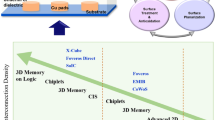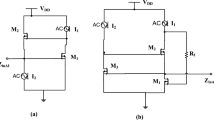Abstract
The power efficiency is an extremely essential feature in the modern mobile computing and autonomous sensors node applications. Voltage scaling is the significant technique to attain power-efficient operation utilizing voltage level shifters. Level shifters (LSs) with high performance are vital interconnecting circuits to achieve compactness in the multiple-supply voltage low-power VLSI systems. This article presents a fast and ultra-low static power LS adopting Muller C-cell along with stacked inverter. In addition, the Muller C-cell-based level shifter (MCLS) uses a pass transistor and dynamic threshold MOS with INWE-aware device sizing to make stronger the pull-down network and Wilson current mirror/source in the pull-up network to support Muller C-cell for level shifting operation. The structure of Muller C-cell helps to achieve ultra-low standby power in addition to fast switching, as expected. The MCLS is implemented in 180 nm CMOS technology and its performance is evaluated through Spectre Circuit Simulator using Cadence (Virtuoso) platform. From the simulated results, it is observed that the MCLS takes delay of 2.4 ns and consumes energy of 127 fJ/transition for the level shifting from 500 mV to 1.8 V with input frequency (\(f _\mathrm{in} \)) of 1 MHz. It is also noted that the MCLS consumes static power of 47.7 pW at standby mode and it has the ability to convert lower input voltage of 410 mV to higher output voltage of 1.8 V. Furthermore, functionality of the MCLS is experimentally confirmed through prototype developed using IC HEF4007UBP and it ensures fast and wider voltage conversion.










Similar content being viewed by others
Data Availability
The authors declare that the data supporting the findings during this research work are available within the paper as listed in Tables 1, 2 and 3. The schematic of the work is developed on CADENCE platform (Virtuoso schematic editor) and the performance analysis is performed by creating simulation set-up in the Analog Design Environment (ADE) by choosing model libraries, Spectre Circuit Simulator with required stimulus details. In addition, parametric analysis tool is used and the simulated results are obtained on the waveform viewer.
References
M. Alioto, Ultra-low power VLSI circuit design demystified and explained: a tutorial. IEEE Trans. Circuits Syst. I Regul. Pap. 59(1), 3–29 (2012)
V.J. Arulkarthick, R. Selvakumar, C. Arvind et al., High performance contention-eased full-swing level converter for multi-supply voltage systems. Sādhanā 46(4), 220 (2021)
F. Assaderaghi et al., Dynamic threshold-voltage MOSFET (DTMOS) for ultra-low voltage VLSI. IEEE Trans. Electron Devices 44(3), 414–422 (1997)
Y. Cao et al., A compact 31.47 fJ/conversion sub-threshold level shifter with wide conversion range in 65 nm MTCMOS. IEEE Access 6, 54976–54981 (2018)
S.M. Kang, Y. Leblebici, C. Kim, CMOS Digital Integrated Circuits: Analysis and Design (Tata McGraw-Hill Education Private Limited, New Delhi, 2016)
Y. Kim, et al., SLC: split-control Level Converter for dense and stable wide-range voltage conversion, in IEEE Proceedings of the ESSCIRC (ESSCIRC) (2012), pp. 478–481
M. Lanuzza, P. Corsonello, S. Perri, Fast and wide range voltage conversion in multisupply voltage designs. IEEE Trans. VLSI Syst. 23(2), 388–391 (2015)
V.L. Le, T.T.H. Kim, An area and energy efficient ultra-low voltage level shifter with pass transistor and reduced-swing output buffer in 65 nm CMOS. IEEE Trans. Circuits Syst. II Express Briefs 65(5), 607–611 (2018)
T.T. Liu, J.M. Rabaey, A 0.25 V 460 nW asynchronous neural signal processor with inherent leakage suppression. IEEE J. Solid-State Circuits 48(4), 897–906 (2013)
R. Lotfi et al., Energy-efficient wide-range voltage Level Shifters reaching 4.2 fJ/Transition. IEEE Solid-State Circuits Lett. 1(2), 34–37 (2018)
S. Lutkemeier, U. Ruckert, A subthreshold to above-threshold level shifter comprising a Wilson current mirror. IEEE Trans. Circuits Syst. II Express Briefs 57(9), 721–724 (2010)
S. Luo, C. Huang, Y. Chu, A wide-range level shifter using a modified Wilson current mirror hybrid buffer. IEEE Trans. Circuits Syst. I Regul. Pap. 61, 1656–1665 (2014)
D.E. Muller, Theory of Asynchronous Circuits. Report no. 66 (Digital Computer Laboratory, University of Illinois, Urbana-Champaign, 1955)
D.E. Muller, W.S. Bartky, A theory of asynchronous circuits, in International Symposium on the Switching Theory in Harvard University (1959), pp. 204–243
J. Nunez, J.M. Quintana, M.J. Avedillo, Fast and area efficient multi-input Muller C-element based on MOS-NDR. IEEE Int. Symp. Circuits Syst. (2009). https://doi.org/10.1109/ISCAS.2009.5118129
S. Rajendran, A. Chakrapani, A 16 ns, 28 fJ wide-range Sub-threshold level converter using low-voltage current mirror. Circuits Syst. Signal Process. 40(3), 1479–1495 (2021)
S. Rajendran, A. Chakrapani, Fast and energy-efficient level shifter using split-control driver for mixed signal systems. Arab. J. Sci. Eng. 46(10), 10281–10286 (2021)
V.I. Varshavsky, Threshold Element and Method of Designing the Same United States Patent US 6,338,157 B1 (2002)
N.H.E. Weste, D.M. Harris, C.M.O.S.V.L.S.I. Design, A Circuits and Systems Perspective (Addison-Wesley, Pearson, 2011)
L. Wen et al., Sub-threshold level shifter with self-controlled current limiter by detecting output error. IEEE Trans. Circuits Syst. II Express Briefs 63(4), 346–350 (2016)
L. Xinfu, et al., A Study of Inverse Narrow Width Effect of 65 nm Low Power CMOS Technology 9th ICSICT (2008), pp. 1138–1141
H. You et al., An energy-efficient level shifter for ultra-low voltage digital LSIs. IEEE Trans. Circuits Syst. II Express Briefs 67, 3357–3361 (2020)
Z. Yong et al., An energy-efficient and wide-range voltage level shifter with dual current mirror. IEEE Trans. Very Large Scale Integr. Syst. 25(12), 3534–3538 (2017)
Y. Zhang et al., A batteryless 19 WMICS/ISM-band energy harvesting body sensor node SoC for ExG applications. IEEE J. Solid-State Circuits 48(1), 199–213 (2013)
W. Zhao et al., A 65-nm 25.1 ns 30.7 fJ robust sub-threshold level shifter with wide conversion range. IEEE Trans. Circuits Syst. II Express Briefs 62(7), 671–675 (2015)
J. Zhou et al., A 40 nm inverse-narrow-width-effect-aware subthreshold standard cell library, in Proceeding of DAC (2011), pp. 441–446
Author information
Authors and Affiliations
Corresponding author
Ethics declarations
Conflict of interest
The authors declare that they have no conflict of interest.
Additional information
Publisher's Note
Springer Nature remains neutral with regard to jurisdictional claims in published maps and institutional affiliations.
Rights and permissions
About this article
Cite this article
Rajendran, S., Chakrapani, A. Ultra-Low-Power and Fast Voltage Level Shifter Using Muller C-Cell for VLSI Systems. Circuits Syst Signal Process 41, 6530–6546 (2022). https://doi.org/10.1007/s00034-022-02098-0
Received:
Revised:
Accepted:
Published:
Issue Date:
DOI: https://doi.org/10.1007/s00034-022-02098-0




